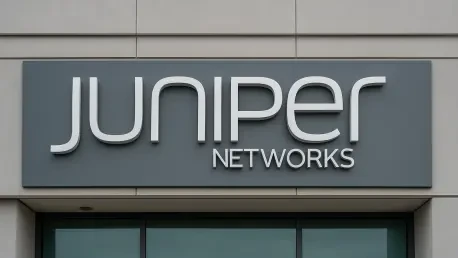In a bold move to amplify its influence in the networking sphere, Hewlett Packard Enterprise (HPE) recently announced the acquisition of Juniper Networks. This significant acquisition is poised to shake the foundations of the networking industry, positioning HPE as a formidable contender against long-standing leaders such as Cisco. The integration of Juniper allows HPE to strengthen its network solutions portfolio, an essential component for thriving in today’s increasingly interconnected cloud-centric world. The focus isn’t simply on expanding business but on offering innovative solutions tailored to the evolving demands of technologies like artificial intelligence and photonics.
The Strategic Importance of Network Infrastructure
Network Infrastructure as a Foundation for AI and High-Performance Computing
Network infrastructure has emerged as a pivotal element in advancing critical technological fields such as artificial intelligence and high-performance computing. HPE’s acquisition of Juniper underscores the importance of a robust network to support these advancements efficiently. The CEO of HPE, Antonio Neri, emphasized the symbiotic relationship between AI and network infrastructure, asserting that a formidable network is a prerequisite for maximizing AI’s potential. Therefore, this acquisition is more than a mere merger; it is a strategic alignment to ensure HPE can deliver unprecedented levels of performance and innovation.
By leveraging Juniper’s AI-Native Networking platform, HPE plans to provide improved solutions that address the weaknesses presently observed in its Aruba Networking functions. The added capabilities from Juniper will not only boost HPE’s product offerings but also enhance the efficiency and reliability of AI deployments. As organizations increasingly rely on intelligent systems, the need for networks capable of handling voluminous data and rapid processing speeds has become crucial. HPE is focusing on creating an integrated ecosystem that supports such future-ready technologies.
Juniper’s AI Integration and Networking Platform
Integrating Juniper’s advanced AI capabilities signifies an important chapter in HPE’s plan to overhaul its networking strategies. Juniper’s AI-Native Networking Platform stands as a strong pillar in augmenting HPE’s existing offerings. This integration reflects HPE’s commitment to staying ahead of the curve by adopting technologies that are not only contemporary but also forward-looking, ensuring the company is prepared for future challenges and opportunities.
The benefits extend beyond enhanced product lines. The strategic acquisition ensures better management of data center infrastructure through capabilities like Apstra’s management solutions, further solidifying HPE’s stance as a comprehensive networking solutions provider. Juniper’s security portfolio adds another layer, fortifying HPE’s approach to handling emerging security challenges in the digital landscape. This multifaceted strategy is aimed at providing a seamless and fortified hybrid cloud solution tailored to meet varying organizational needs.
Navigating the Competitive Landscape
Challenges of Competing with Cisco
Despite HPE’s robust strategies and the promising aspects of the Juniper acquisition, the company faces significant challenges in competing with industry giant Cisco. Cisco, having established its dominance over decades, represents a considerable hurdle for any competitor aiming to dethrone its position. While foregoing such a predictable and formidable competitor seems daunting, HPE is determined to innovate and carve out a significant share of the networking market through strategic integrations and technological advancements.
One of the main challenges HPE confronts is the need to rejuvenate Juniper’s offerings, which some critics argue have become stagnant in recent times. The challenge lies in swiftly revitalizing these products to realize significant growth and innovation. It requires a delicate balance between maintaining Juniper’s core competencies and integrating them effectively with HPE’s existing product lines.
Reclaiming Market Share and Fostering Innovation
HPE’s ambition to reclaim market share from Cisco isn’t merely about competition; it’s about positioning itself as a leader in the networking domain. The company intends to achieve this by fostering innovation and seamlessly integrating Juniper’s offerings into its portfolio. Addressing the market’s evolving needs, HPE is focused on delivering solutions that are not only competitive but also offer a distinct value proposition to customers across the globe.
The U.S. government’s approval, after HPE and Juniper agreed to concessions like making Mist AIOps source code available, further amplifies the strategic momentum behind this acquisition. This move reassures stakeholders that the acquisition aligns with regulatory standards, easing transitional challenges. The evolving competitive landscape means HPE’s journey is continuously shaped by how the industry responds to this strategic shift. Measures for sustained innovation and effective execution are imperative as the company endeavors to redefine networking paradigms.
Expanding Horizons Through Strategic Execution
In a strategic and bold initiative, Hewlett Packard Enterprise (HPE) has announced its acquisition of Juniper Networks, marking a significant shift in the networking industry landscape. This acquisition positions HPE to directly challenge established industry giants like Cisco, enhancing its market presence and influence. By incorporating Juniper’s advanced technology and expertise, HPE aims to robustly expand its network solutions portfolio, which is crucial for success in today’s cloud-centric and interconnected digital era. The integration goes beyond mere business expansion; it underscores HPE’s commitment to providing innovative solutions that meet the changing needs of emerging technologies, including artificial intelligence and photonics. This strategic move is indicative of HPE’s dedication to staying ahead in the competitive networking field, ensuring they can offer cutting-edge solutions tailored to the evolving demands of modern technology sectors.









